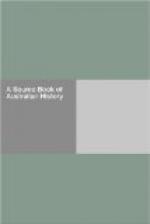Tuesday, May 1st. This morning a party of us went ashore to some huts not far from the watering-place, where some of the natives are daily seen; here we left several articles, such as cloth, looking glasses, combs, beads, nails, etc.; after this we made an excursion into the Country, which we found diversified with woods, lawns, and marshes. The woods are free from underwood of every kind, and the trees are at such a distance from one another, that the whole country, or at least a great part of it, might be cultivated without having to cut down a single tree. We found the soil everywhere, except in the marshes, to be a light white sand, and produceth a quantity of good grass, which grows in little tufts about as big as one can hold in one’s hands, and pretty close to one another; in this manner the surface of the ground is coated. In the woods between the trees, Dr. Solander had a bare sight of a small animal something like a rabbit, and we found the dung of an animal which must feed upon grass, and which, we judge, could not be less than a deer; we also saw the track of a dog, or some such like animal. We met with some huts and places where the natives had been, and at our first setting out one of them was seen; the others had, I suppose, fled upon our approach. I saw some trees that had been cut down by the natives with some sort of a blunt instrument, and several trees that were barked, the bark of which had been cut by the same instrument; in many of the trees, especially the Palms, were cut steps of about 3 or 4 feet asunder for the conveniency of climbing them. We found 2 sorts of gum, one sort of which is like gum-dragon, and is the same, I suppose, Tasman took for gum-lac; it is extracted from the largest tree in the woods.
Thursday, 3rd. After this we took water, and went almost to the head of the Inlet, where we landed and travelled some distance inland. We found the face of the country much the same as I have before described, but the land much richer, for instead of sand, I found in many places a deep black soil, which we thought was capable of producing any kind of grain. At present it produceth besides timber, as fine meadow as ever was seen; however, we found it not all like this, some few places were very rocky, but this, I believe to be uncommon.
Sunday, 6th. The great quantity of plants Mr. Banks and Dr. Solander found in this place, occasioned my giving it the name of Botany Bay. During our stay in this harbour I caused the English colours to be displayed ashore every day, and an inscription to be cut out upon one of the trees near the watering-place, setting forth the ship’s name, date, etc. Having seen everything the place afforded, we at daylight in the morning, weighed with a light breeze at N.W. and put to sea, and the wind soon after coming to the Southward, we steered along shore N.N.E., and at noon were about 2 or 3 miles from the land, and abreast of a bay, wherein there appeared to be a safe anchorage, which I called Port Jackson. It lies 3 leagues to the Northward of Botany Bay.




